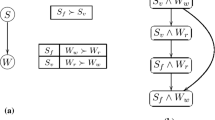Abstract
Influence networks are Bayesian networks whose probabilities are approximated via expert provided influence constants. They represent a modeling and analysis formalism for addressing complex decision problems. In this paper, we present a comprehensive theory of influence networks that incorporates design constraints for consistency, temporal issues and a dynamic programming evolution of the influence constants. We also include numerical evaluations for several example timed influence networks.
Similar content being viewed by others
References
Agosta, J.M.: Conditional inter-causally independent node distributions, a property of noisy-OR models. In: Proceedings of the 7th Conference on Uncertainty in Artificial Intelligence (1991)
Chang, K.C., Lehner, P.E., Levis, A.H., Zaidi, A.K., Zhao, X.: On causal influence logic. Technical report, George Mason University, Center of Excellence for C31 (1994)
Cooper, G.F.: The computation complexity of probabilistic inference using Bayesian belief networks. Artif. Intell. 42(2–3), 393–405 (1990)
Drudzel, M.J., Henrion, M.: Intercausal reasoning with uninstantiated ancestor nodes. In: Proceedings of the 9th Conference on Uncertainty in Artificial Intelligence (1993)
Haider, S.: On computing marginal probability intervals in probabilistic inference networks. In: Proceedings of IEEE-SMC Conference (2003)
Haider, S.: A hybrid approach for learning parameters of probabilistic networks from incomplete databases. Design and application of hybrid intelligent systems. In: Proceedings of the Third International Conference on Hybrid Intelligent Systems (HIS’03). IOS Press, Amsterdam. ISBN 158603-394-8 (2003)
Haider, S., Zaidi, A.K., Levis, A.H.: A heuristic approach for best set of actions determination in influence nets. In: Proc. IEEE International Conference on Information Reuse and Integration, Las Vegas (2004)
Haider, S., Levis, A.H.: An approximation technique for belief revision in timed influence nets. In: Proceedings of Command and Control Research and Technology Symposium (2004)
Haider, S., Zaidi, A.K.: Transforming timed influence nets into time sliced Bayesian networks. In: Proceedings of Command and Control Research and Technology Symposium (2004)
Haider, S., Levis, A.H.: Dynamic influence nets: an extension of timed influence nets for modeling dynamic uncertain situations. In: Proc. 10th International Command and Control Research and Technology Symposium, Washington, DC (2005)
Haider, S., Zaidi, A.K.: On temporal analysis of timed influence nets using point graphs. In: Proc. of the 18th International FLAIRS Conference, Florida (2005)
Haider, S., Levis, A.H.: Effective courses of action determination to achieve desired effects. IEEE Trans. Syst. Man Cybern., Part A, Syst. Humans 37(6), 1140–1150 (2007)
Howard, R., Matheson, J.E.: Influence diagrams. In: Howard, R., Matheson, J. (eds.) Readings on the Principles and Applications of Decision Analysis, vol. 2, pp. 721–762. Strategic Decisions Group, Menlo Park (1981)
Howard, R.A., Matheson, J.E.: Influence diagram retrospective. Decis. Anal. 2(3), 144–147 (2005)
Howard, R.A., Matheson, J.E., Merkhofer, M.W., Miller, A.C., North, D.W.: Comment on influence diagram retrospective. Decis. Anal. 3(2), 117–119 (2006)
Kschischang, F.R., Frey, B.J.: Iterative decoding of compound codes by probability propagation in graphical models. IEEE J. Sel. Areas Commun. 16, 219–230 (1998)
McEliece, R.J., McKay, D.J.C., Cheng, J.F.: Turbo decoding as an instance of Pearl’s belief propagation algorithm. IEEE J. Sel. Areas Commun. 16(2), 140–152 (1998)
Murphy, K.P., Weiss, Y., Jordan, M.I.: Loopy belief propagation for approximate inference: an empirical study. In: Proceedings of Uncertainty in AI (1999)
Neapolitan, R.E.: Learning Bayesian Networks. Prentice Hall (2003)
Faraz Rafi, M., Zaidi, A.K., Papantoni-Kazakos, P., Levis, A.H.: Optimization of actions in activation timed influence nets. In: Informatica (2009)
Pearl, J.: Probabilistic Reasoning in Intelligent Systems: Networks of Plausible Inference. Morgan Kaufmann, San Mateo (1988)
Rosen, J.A., Smith, W.L.: Influence net modeling with causal strengths: an evolutionary approach. In: Proceedings of the Command and Control Research and Technology Symposium, Naval Post Graduate School, Monterey, June 25–28, 1996
Rosen, J.A., Smith, W.L.: Influencing global situations: a collaborative approach. In: US Air Force Air Chronicles (1996)
Rosen, J.A., Smith, W.L., Smith, E.S., Maldony, M.A.: Planning with influence net modeling: an architecture for distributed, real-time collaboration. In: Military Operations Research Symposium (MORS) (1998)
Rosen, J.A., Smith, W.L.: Influence net modeling for strategic planning: a structured approach for information operations. In: Phalanx, vol. 33 (2000)
Shachter, R.D.: Evaluating influence diagrams. Oper. Res. 34(6), 871–882 (1986)
Wagenhals, L.W.: Course of action development and evaluation using discrete event system models of influence nets. Ph.D. dissertation, George Mason University (2000)
Wagenhals, L.W., Levis, A.H.: Course of action development and evaluation. In: Proceedings of the 2000 Command and Control Research and Technology Symposium (2000)
Wagenhals, L.W.: Levis, A.H.: Modeling effects based operations in support of war games. In: Proc. of the 15th International Symposium on Aerospace/Defense Sensing, Internal Society for Optical Engineering. Proc SPIE 4367 (2001)
Wagenhals, L.W., Levis, A.H.: Modeling support of effects-based operations in war games. In: Proc. 2002 Command and Control Research and Technology Symposium, Monterey (2002)
Wagenhals, L.W., Levis, A.H., McCrabb, M.: Effects based operations: a historical perspective for a way ahead. In: Proc. 8th Int’l Command and Control Research and Technology Symposium. National Defense University, Washington (2003)
Wagenhals, L.W., Shin, I., Levis, A.H.: Creating executable models of influence nets with coloured petri nets. Int. J. STTT (Springer-Verlag) 1998(2), 168–181 (1998)
Wagenhals, L.W., Reid, T.J., Smillie, R.J., Levis,A.H.: Course of action analysis for coalition operations. In: Proceedings of 6th International Command and Control Research and Technology Symposium, Annapolis (2001)
Wagenhals, L.W., Wentz, L.K.: New effects-based operations models in war games. In: Proceedings of the 2003 International Command and Control Research and Technology Symposium. National Defense University, Washington (2003)
Wagenhals, L.W., Levis, A.H.: Course of action analysis in a cultural landscape using influence nets. In: Proc. IEEE Symp. on Computational Intelligence for Security and Defense Applications, Honolulu (2007)
Zaidi, A.K., Wagenhals, L.W., Haider, S.: Assessment of effects based operations using temporal logic. In: Proc. of the 10th International Command and Control Research and Technology Symposium (2005)
Author information
Authors and Affiliations
Corresponding author
Additional information
This work was supported by the Air Force Office of Scientific Research (AFOSR) under Grants FA9550-05-1-0106 and FA9550-05-1-0388.
Rights and permissions
About this article
Cite this article
Zaidi, A.K., Mansoor, F. & Papantoni-Kazakos, T.P. Theory of Influence Networks. J Intell Robot Syst 60, 457–491 (2010). https://doi.org/10.1007/s10846-010-9425-8
Received:
Accepted:
Published:
Issue Date:
DOI: https://doi.org/10.1007/s10846-010-9425-8




